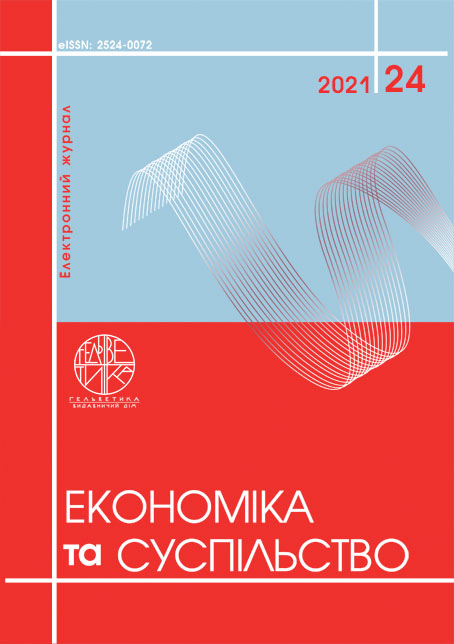THE ANALYSIS OF THE RELATIONSHIP BETWEEM INFLATION AND UNEMPLOYMENT IN THE EU RISING COUNTRIES
Abstract
Empiric and regression analysis of the relationship between inflation and unemployment in the EU rising countries (Poland, Czech Republic, Slovenia, Estonia) have been conducted. Empiric analysis has been shown that there is positive relationship between inflation and unemployment in these countries: at the beginning of the market transformations the increase in both macroeconomic indicators, inflation and unemployment, has been observed, but the governments used effectively the instruments of inflation targeting, namely nominal rates regulation, money supply regulation, exchange rate targeting), and they stopped the inflation spiral «wages – prices» as well as solved the problem of cyclical unemployment. Obtained results of the regression analysis proved the statement that there is unidirectional relationship between inflation and unemployment in the ЕU rising countries; moreover inflation is the cause and unemployment is the consequence. In order to optimize the ration between inflation and unemployment, it has been made the following recommendations. Firstly, it is needed to develop smart enterprises based on artificial intelligence, digital modeling, optimization of cyberphysical spatial systems and mechanisms of self-organization in economic decision-making. Secondly, it is needed to improve transmission mechanism of the monetary policy using rate instrument. Further decrease in nominal interest rates in the rising EU countries spread the credit possibilities of commercial banks and increase investment attractiveness to borrow money on national currencies that, I turn, allows to form long-run adaptive expectations of the population. Thirdly, it is important to spread the use of cryptocurrencies, digital decentralized types of payments, that are stable enough to the cyclical fluctuations and economic crises. In view of the limits of emission of cryptocurrencies, it declines inflation risks and leads to the formation of deflation climate of analyzed countries. The implementation of these steps will help to solve two actual issues in the ЕU rising countries namely form long-run adaptive inflation expectations and achieve natural unemployment rate in the conditions of macroeconomic equilibrium.
References
Вишневський В. П. Смарт-промисловість: напрями становлення, проблеми і рішення: кол. монографія. Київ : Інститут економіки промисловості НАН України, 2019. 464 с.
Жумадилов Э., Козубеков А. Анализ взаимосвязи между динамикой инфляции и темпами экономического роста в Кыргызстане. Бишкек, 2013. 28 с.
Лопух К.В. Взаємозв’язок між інфляцією та безробіттям: монетаристський підхід. Ефективна економіка. 2013. №9.
Юрчишин В. Макроекономічні взаємозв’язки і монетарні впливи політики зростання і розвитку в успішних висхідних країнах Європи та Україні [в кол. монограф.]. Київ : Заповіт, 2019. 148 c.
Bayar Y., Diaconu L. Emerging Markets: European Transition Economies. Labor History. 2020. Volume 61. Issue 5–6.
Hansen L.P. Uncertainty within Economic Models. Singapore: World Scientific, 2014. 455 P.
Felps E.S. Mass Flourishing. Princeton: Princeton University Press, 2013. 404 P.
Phillips A. W. The Relation between Unemployment and the Rate of Change of Money Wage Rates in the United Kingdom, 1861-1957. Economica. 1958. Issue 25, No. 2. PP. 283–99.
Lucas R. E., Sargent T. G. «New» Explanations of the Persistence of Inflation and Unemployment. Proceedings of a Conference. Edgartown, Massachusetts, 1978. 40 P.
Ritzberger-Grünwald D. The impact of external shocks on inflation dynamics in CESEE. BIS Papers. 2020. No 70. PP. 161–170.
Samuelson P. A., Solow R. M. Analytical Aspects of Anti-Inflation Policy. American Economic Review. 1960. Issue 50, No. 2. PP. 177–94.
Washington S., Karlafis M.G., Mannering F., Anastasopoulos P. Statistical and Econometric Methods for Transportation Data Analysis. New York: CRC Press, 2020. 464 P.
Офіційний сайт Європейського Союзу. URL: https://www.ec.europa.eu.
Vishnevskij V.P. (2019). Smart-promislovist: napryami stanovlennya, problemi i rishennya: kol. monografiya. Kyiv: Institut ekonomiki promislovosti NAN Ukrayini, 464 р.
Zhumadilov E., Kozubekov A. (2013). Analiz vzaimosvyazi mezhdu dinamikoj inflyaczii i tempami ekonomicheskogo rosta v Kyrgyzstane. Bishkek, 28 р.
Lopukh K.V. (2013). Vzayemozv'yazok mizh inflyacziyeyu ta bezrobittyam: monetaristskij pidkhid. Efektivna ekonomika, no. 9.
Yurchishin V. (2019). Makroekonomichni vzayemozvyazki i monetarni vplivi politiki zrostannya i rozvitku v uspishnikh viskhidnikh krayinakh Yevropi ta Ukrayini [v kol. monograf.]. Kyiv: Zapovit, 148 р.
Bayar Y., Diaconu L. (2020). Emerging Markets: European Transition Economies. Labor History, vol. 61, issue 5-6.
Hansen L.P. (2014). Uncertainty within Economic Models. Singapore: World Scientific, 455 р.
Felps E.S. (2013). Mass Flourishing. Princeton: Princeton University Press, 404 р.
Phillips A.W. (1958). The Relation between Unemployment and the Rate of Change of Money Wage Rates in the United Kingdom, 1861–1957. Economica, issue 25, no. 2, рр. 283–99.
Lucas R.E., Sargent T.G. (1978). «New» Explanations of the Persistence of Inflation and Unemployment. Proceedings of a Conference. Edgartown, Massachusetts, 40 р.
Ritzberger-Grünwald D. (2020). The impact of external shocks on inflation dynamics in CESEE. BIS Papers, no. 70, рр. 161–170.
Samuelson P.A., Solow R.M. (1960). Analytical Aspects of Anti-Inflation Policy. American Economic Review, issue 50, no. 2, рр. 177–94.
Washington S., Karlafis M.G., Mannering F., Anastasopoulos P. (2020). Statistical and Econometric Methods for Transportation Data Analysis. New York: CRC Press, 464 р.
Ofitsiinyi sait Yevropeiskoho Soiuzu. URL: https://www.ec.europa.eu


